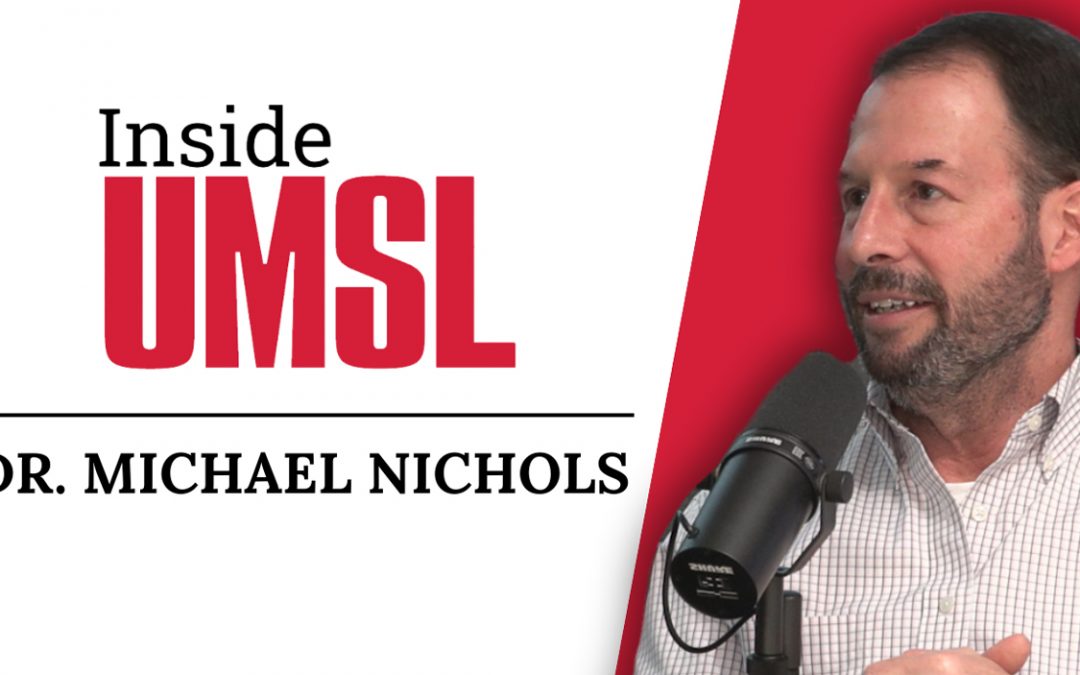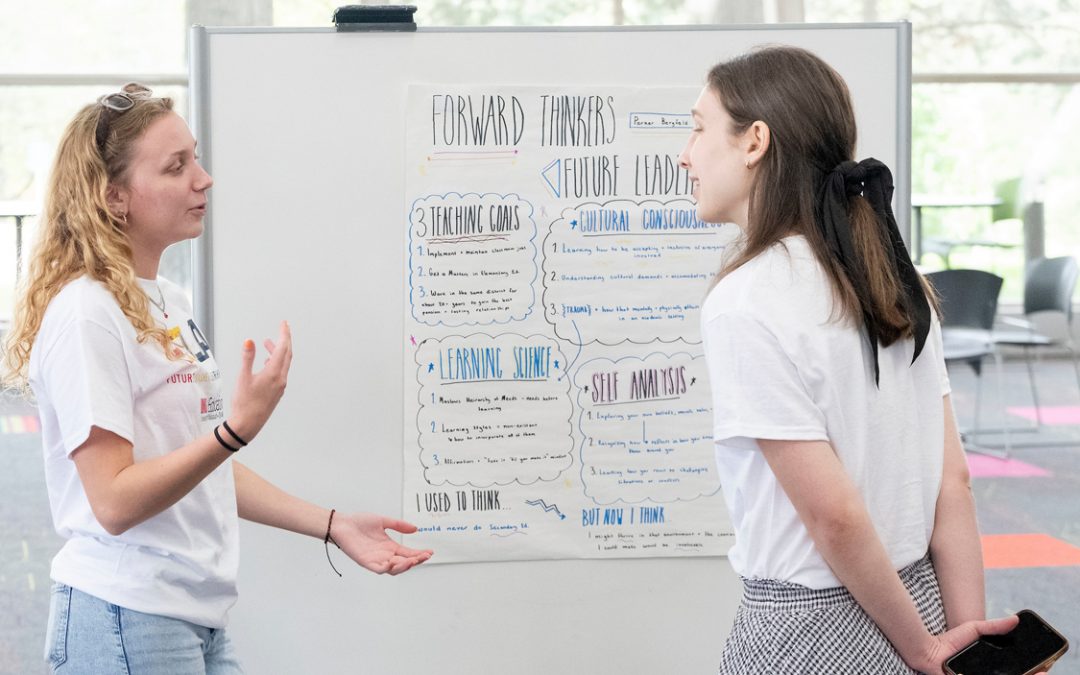
UMSL Political scientists David Kimball (at left) and Anita Manion shared insights on the redistricting process underway across the United States. (Photos by August Jennewein)
The lines of political battle are literally changing across the country as states go through the process of redistricting, as happens each decade.
This week, the Missouri Legislature is expected to debate a proposed redistricting map that will likely maintain the current 6-2 ratio of Republican to Democratic controlled seats from the state in the U.S. House of Representatives.
Redistricting processes can also impact the composition of the state legislature itself as well as local governments. The City of St. Louis, for example, is preparing to adopt new ward maps that will shrink the number of members of the Board of Alderman from 28 to 14.
These changes in representation can’t help but impact the policies that get enacted by elected bodies at every level of government.
In the latest installment of its Ask an Expert series, UMSL Daily spoke to University of Missouri–St. Louis political scientists David Kimball and Anita Manion about the process and what it portends.
Why are states undergoing redistricting?
Anita Manion: I would like to step back from redistricting for one second and say that it is based on the U.S. Census. We have low response rates sometimes, and so I’m highlighting to folks who are reading this the importance of responding to the census because that’s how redistricting is determined. That’s the first critical piece. If we talk about the federal level, there are 435 seats in the House of Representatives. The number of seats doesn’t change. As population shifts, we reallocate those seats based on gains or losses.
In the 2020 census, Missouri had population growth of 2.8%, but that was a lot less than the national growth. We were lucky that we were able to maintain our congressional seats. We didn’t lose a seat like we did after the previous census in 2010. But we did fall to the 19th largest state and Illinois fell to the sixth largest.
There are different ways to do redistricting. In Missouri, the legislature oversees the process. Other places have independent commissions that do this. Which is more common?
David Kimball: A majority of states are like Missouri in having the legislature redraw district boundaries. That’s been a controversial practice because often the members of the state legislature who are drawing the congressional district boundaries are interested in running for office in one of those new districts. They have an incentive, therefore, to draw new boundaries that make it easier for them to win. There’s an opportunity for them to draw districts that favor their own political self-interest rather than the interests of the broader constituents.
That’s why some states have adopted a commission outside the legislature to draw district boundaries with the thought that might be a little bit less open to political influence. Or at least it would be somebody drawing the districts that doesn’t have a vested political interest in the outcome.
The process of redrawing districts for political benefit is not something new. Gerrymandering, the origins of the word itself, go back more than 200 years. What has changed that makes people see it as a bigger problem today?
AM: You’re certainly right that politicians and political parties are always going to use the rules how they can to gain an advantage. That’s not new. But what is new is the level of technology that allows them to, at a granular level, identify and determine who they want in which districts. There’s also a trend with more and more liberals or Democrats tending to move to more urban areas, and more conservatives or Republicans being more spread out in rural areas. That can actually, in this era, benefit the Republican Party because it’s hard to divide those more liberal or Democratic voters into more districts if they’re all clustered together.
The Republican Party, frankly, has been pretty savvy – really bolstered in 2010 – in focusing on getting control of state legislatures. Because if you do that, then you control the redistricting process. You can look at a state like Missouri. We think we’re going to have the same allocation of six Republican seats and two Democratic seats in the House of Representatives. But if you look at the vote share in the 2020 presidential election, you have about 57%, Republican and about 41% Democrat in Missouri.
DK: For congressional districts and state legislative districts, one concern is the partisan fairness of the maps, and a contributing factor is that voters today are more loyal to one particular party than they used to be a few decades ago. Fewer voters split their tickets between multiple parties when they cast their votes, and there’s much more data available now about the voting behavior of people down to the block level, so the people drawing the new district boundaries can be very confident that if they draw a district that’s, say, 60% Democratic, it’s probably going to remain that way for the next 10 years until it’s time to do another set of redistricting.
In Missouri, it looks like the legislature is going to draw a map that retains the Republicans 6-2 advantage in Congressional seats, but there had been some talk of drawing at map that would give the Republican Party a chance to add a seventh seat. Why does that idea not seem to be winning out?
AM: When they draw these maps, it’s to a party’s advantage to make those districts noncompetitive, so a solidly Democratic or solidly Republican district. That’s what the Republicans in Missouri have right now with the 6-2 map. If they keep that, they basically know those six seats are safe. That noncompetitiveness isn’t necessarily great for more centrist voters or for equal representation because what it does, if the district is solidly Republican or celebrate Democrat, is make the real race as the primary. You’re going to get candidates going to the left or to the right to win the primary race in those districts, rather than having a general election where people go more to the center. But if the Republicans go with a 7-1 map, carving up the Kansas City area, it means you’re getting some more Democrats into those other districts and can make those more competitive and less solidly Republican.
DK: The increasing nationalization of politics is also contributing to these discussions. In the past, states largely did redistricting on their own, maybe without paying so much attention to what was happening in other states. But now some in the Republican Party in the Missouri Legislature are wondering, “Do we draw a 7-1 map so that nationally we have as many Republican districts as possible?”
What does it look like is going to happen nationally with Republicans controlling so much of the redistricting process in so many of these states? How much of an advantage does it look like the party will gain?
DK: Going into the redistricting process, at least looking at the congressional districts, there was the expectation that it would benefit Republicans substantially because Republicans control the redistricting process in many more states. Although in many states – like Missouri, assuming the map that passed the state house, passes the Senate and is adopted – that’s basically ratifying the existing division. So redistricting may not net the Republicans that many additional seats because it’s largely ratifying and strengthening the districts that were drawn 10 years ago in many of these same states by Republicans.
AM: In Missouri, one of the things I think is relevant to our congressional redistricting – and I go back to census and population shifts – is that the first district, which includes the city of St. Louis, was among the top 10 nationally in declining population from the 2010 to 2020 Census. That was a majority African American district back in the 1960s when it was drawn, and it’s the only district in Missouri with a plurality of black voters. That is going to expand more into the suburbs, so there is some discussion about what that map should look like. It’ll still be a solidly Democratic district, but that’s definitely a map that will shift because of the population shrinking in the first district.
When do states have to finish this process?
DK: Practically speaking, you’d like redistricting to be finished in time for the filing for candidates who want to run for office this fall. In Missouri, the primary is in August, and the filing period ends in late March. They need to finish it pretty soon for the state legislative districts and for the congressional districts in Missouri.
There’s a new ward map being voted on in the city of St. Louis that cuts the number of wards from 28 to 14. What do people see as the benefits of wards and fewer representatives on the on the Board of Aldermen?
DK: That was adopted by ballot measure that the voters of St. Louis passed in 2012. I think broadly speaking, the argument was that population in the city of St. Louis had declined substantially. At one time, in the mid-20th century, St. Louis had 800,000 residents, and now it has around 300,000, a little bit under 300,000. Having a Board of Aldermen with 28 wards meant each one is representing a pretty small number of constituents. Reducing the number of wards from 28 to 14 means each member of the Board of Aldermen can represent more people.
AM: In the new plan, there’s seven majority white wards and seven majority black wards to try to help better reflect the racial distribution in the city as well.
In how many cases will that lead to current board members running against each other for seats?
AM: I think all but four current aldermen would be matched against incumbents in the same district. So most of them. There could be four three-way races between incumbents and six races with two incumbents.
One of the concerns in the St. Louis City ward redistricting process has been whether neighborhoods and communities stay together and have the same alderperson. If not – if David and I live in the same neighborhood but he’s a couple blocks away so he goes to someone different for his problems than I do – that can create a level of disparity within the same neighborhood, different representation and different outcomes.
DK: In Missouri, there seems to be more interest in keeping local communities within the same district. The city of St. Louis, in drawing the new Ward boundaries, they seem quite conscious about trying not to split neighborhoods into multiple wards. The commission that’s been working on redistricting for the state house seems to be trying to draw districts that avoid splitting counties and municipalities as much as possible. In a heavily populated county like St. Louis County, there’s too many people to fit in one state legislative seat or one state senate seat. But there seems to be more effort this time around at preserving those local political subdivisions.
How important does redistricting ultimately become in the people that we elect and the policies that get enacted?
AM: One of the big issues to me is that when you get these noncompetitive districts, districts that are very solidly Republican or Democrat, it pushes candidates to be more extreme – either conservative or liberal. That means that we have policies that veer more to the polls instead of the center. It feeds into some of the divisiveness that we have. It can also be a disincentive in that if you’re a Republican in a solidly Democratic area or vice versa, you might not feel motivated or like your voice is heard because we all know who’s going to win St. Louis City or who’s going to win rural Missouri.














